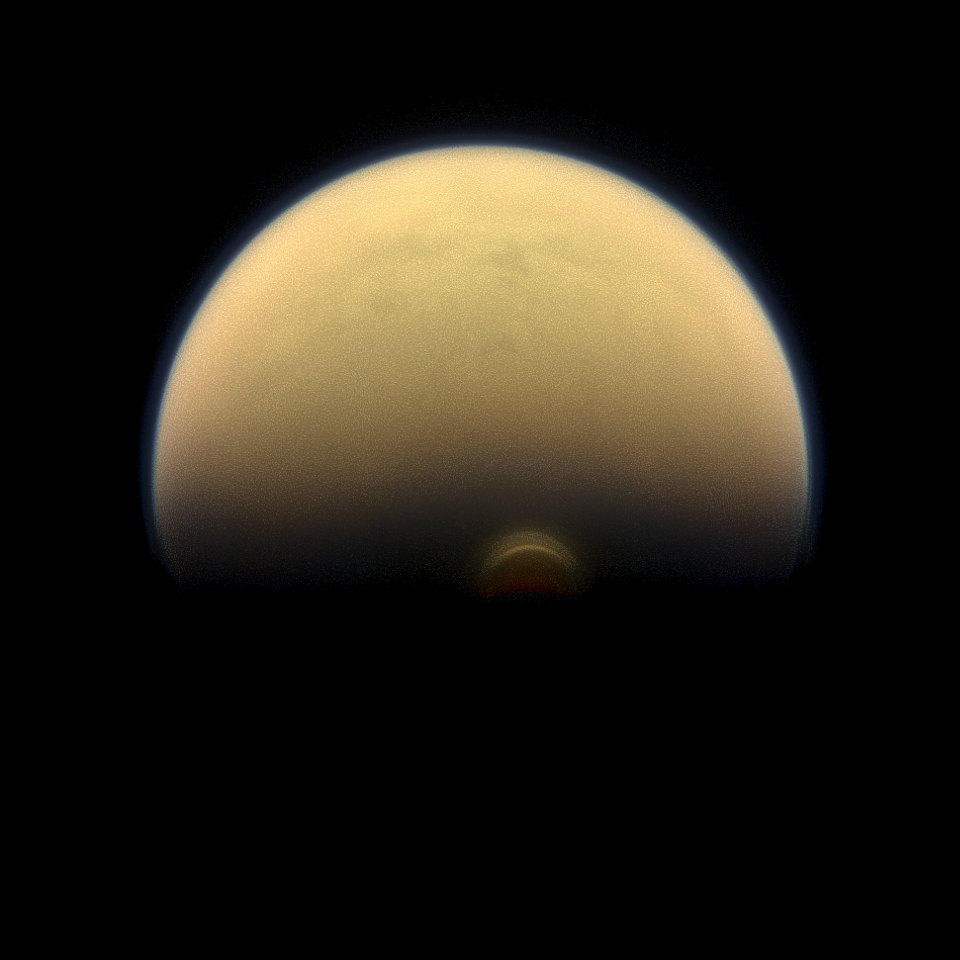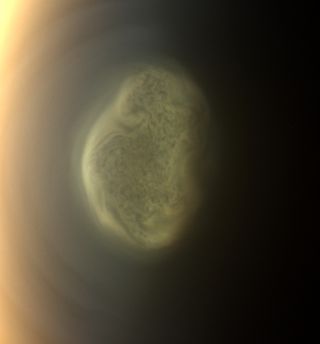Gigantic Ice Cloud Spotted on Saturn Moon Titan (Photos)

NASA's Cassini spacecraft has detected a massive, never-before-seen icy cloud at the south pole of Saturn's huge moon Titan.
The newly spotted feature — part of a cloud system known as the south polar vortex — suggests that winter in the southern hemisphere of Titan will be even colder than predicted, scientists said.
The atmospheric signal "looks pretty normal, then BOOM!, increases," indicating the presence of a brand-new cloud, said Cassini participating scientist Carrie Anderson, of NASA's Goddard Space Flight Center in Greenbelt, Maryland. "I was so excited, I pretty much fell out of my chair." [Amazing Photos: Titan, Saturn's Largest Moon]
Anderson presented the new Cassini results at a news briefing Nov. 11 at the 47th annual meeting of the American Astronomical Society's Division of Planetary Sciences in Oxen Hill, Maryland. She also spoke at the morning session of the conference that day.

Icy clouds

Titan is one of the most intriguing moons of Saturn. It has a thick, nitrogen-dominated atmosphere and is the only world in the solar system other than Earth known to possess stable liquid on its surface.
But Titan's seas are composed of ethane and methane rather than water. Many scientists regard the moon as one of the solar system's best bets to host alien life, though any indigenous Titan organisms would have to be quite different than the kind that evolved on Earth.
Titan also boasts clouds in its dense atmosphere. Some of these lie close to the moon's surface, while others sit higher up in its sky. In 2012, scientists determined that the top of one of Titan's clouds sat at an altitude of about 186 miles (300 kilometers) above the moon's south pole, up in the stratosphere, a stable atmospheric region above the active weather layer.
Get the Space.com Newsletter
Breaking space news, the latest updates on rocket launches, skywatching events and more!
"That cloud is just the tip of a more extensive stratospheric cloud system that has been building up for a little bit of time now, we think, as Titan heads into its southern winter," Anderson said.
A second enormous cloud was only recently spotted lying much lower in the atmosphere. Scientists investigated that cloud's composition using Cassini's Composite Infrared Spectrometer (CIRS) instrument, and by performing laboratory experiments under Titan-like conditions.
The team determined that the newfound cloud is made of smoglike compounds of hydrogen, carbon and nitrogen, each of which changes from a gaseous to a liquid state at a different temperature. While this composition is similar to that of the cloud spotted in 2012, the quantities of material in relation to one another vary, revealing this is a brand-new cloud rather than an evolved form of the older one.
"This cloud is new and separate," Anderson said.
"Coming on strong"
The new cloud sits lower, at a height of about 124 miles (200 km), an unusual altitude for such a massive cloud bank. Its lower location suggests that temperatures on Titan get even lower than the minus 238 degrees Fahrenheit (minus 150 degrees Celsius) projected by the 2012 observation, researchers said.
On Earth, clouds form as water evaporates into the air. At high enough levels, this water vapor condenses into clouds, ultimately raining down. Most of the hydrocarbon clouds on Titan form in the same way.
But it's a different story around Titan's poles. There, atmospheric circulation moves gases from the warmer, spring hemisphere (currently, the northern hemisphere) to the colder southern one. When the gases reach the cooler region, they sink, encountering even colder temperatures on the way down. While some gases rain out, others freeze into layers over different heights, scientists said.
Cassini arrived at Saturn in 2004 — midwinter for the north polar region and midsummer for the south. Each of Titan's seasonslast about 7.5 Earth years, so the moon's southern reaches are now just beginning to transition from fall to winter, and will still be locked in winter's chill when the Cassini mission ends in September 2017.
Ice clouds around the north pole have been disappearing as spring arrives, while new clouds have been forming at the south pole. The overall change indicates that the direction of Titan's global circulation is slowly shifting, researchers said.
The change in direction means that fresh organic vapors in the atmosphere are being carried to the surface as they interact with the clouds. The increased abundance of these gases means that more of them fall to the surface, cooling along the way, according to Anderson. That cooling leads to more clouds, and the cycle continues.
According to Anderson, the colder temperatures mean that southern winter on Titan "is coming on strong."
Follow Nola Taylor Redd on Twitter @NolaTRedd or Google+. Follow us @Spacedotcom, Facebook or Google+. Originally published on Space.com.
Join our Space Forums to keep talking space on the latest missions, night sky and more! And if you have a news tip, correction or comment, let us know at: community@space.com.

Nola Taylor Tillman is a contributing writer for Space.com. She loves all things space and astronomy-related, and enjoys the opportunity to learn more. She has a Bachelor’s degree in English and Astrophysics from Agnes Scott college and served as an intern at Sky & Telescope magazine. In her free time, she homeschools her four children. Follow her on Twitter at @NolaTRedd
Most Popular

